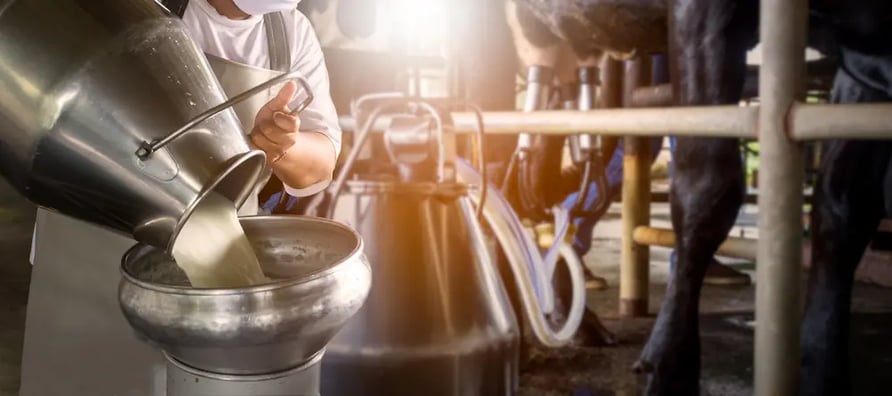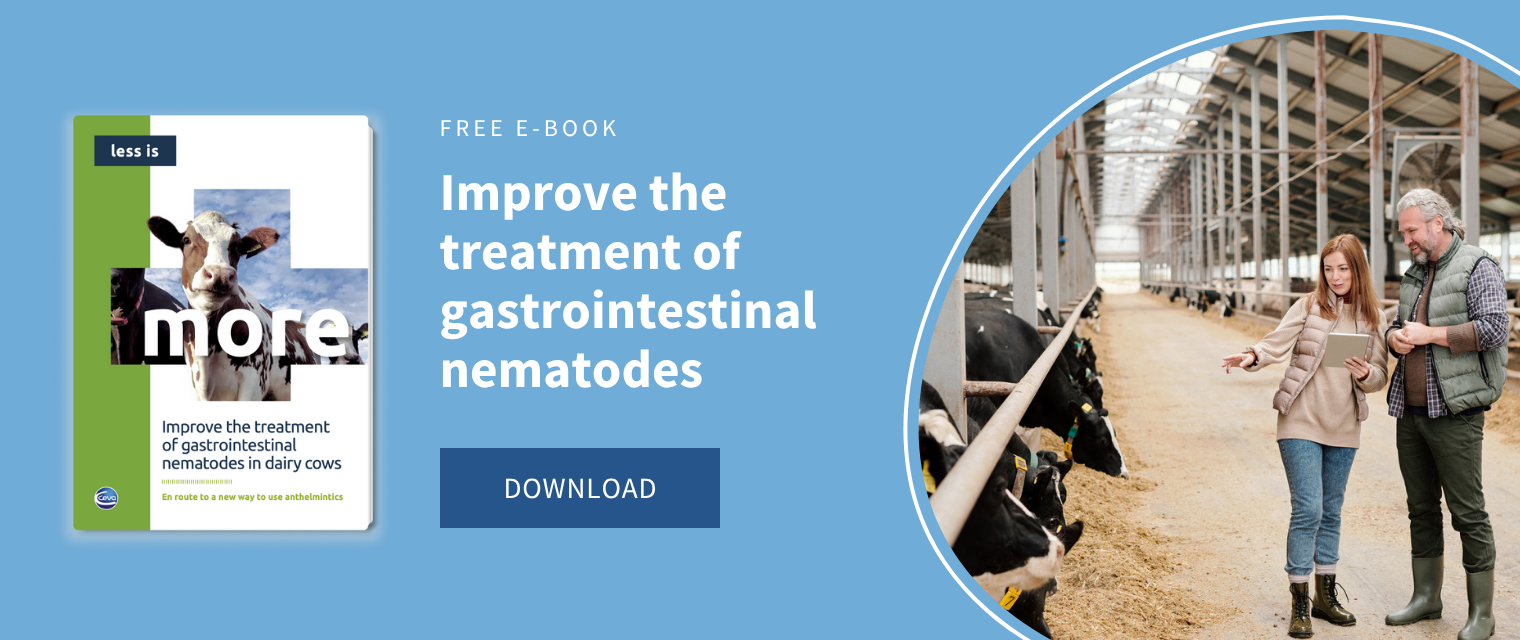The European Union is a substantial producer of dairy products, with an estimated total milk production of around 155 million tonnes per year1. Gastrointestinal nematodes (GIN) cause a significant reduction in milk production leading to a decrease in farm profitability2. The economic impact of GIN infections in dairy cattle has been estimated at around €941 million per year3, in fact, some authors reported that they are second only to mastitis in terms of health costs to dairy farmers4.
Effects of gastrointestinal nematode infections in cattle
GIN infections, common in grazing animals, are detrimental to the health of cattle. By causing tissue lesions, inducing inflammatory reactions or directly feeding on the animal’s blood, GIN mainly lead to a deprivation of the hosts’ nutritional elements2,5.
GIN infections are especially important in first-season grazing (FSG) calves, which can show clinical gastrointestinal and/or haematological signs such as diarrhoea (sometimes with mucous or bloody faeces), dehydration, anaemia, inappetence, reduced growth, weight loss, oedema and hypoalbuminaemia. Severe cases can be fatal5. Animals develop protective immunity after subsequent infections; in spite of the fact that GIN infections are usually subclinical in adult animals, they still cause negative effects on cattle profitability, also increasing susceptibility to other diseases6.
Clinical signs and their intensity depend, amongst other variables, on the nematode species present, since they have different pathogenicity and main target organs, their location in the gastrointestinal tract, parasite burden and the immune status of the host5.
Pathogenesis of gastrointestinal nematodes
GIN affecting the abomasum, especially Ostertagia and Haemonchus, are the most pathogenic nematodes3,5. In general, GIN cause inflammation and damage the gastrointestinal mucosa, favouring protein loss, especially albumin, from blood to the gastrointestinal lumen. Hypoalbuminemia causes a reduction of the blood oncotic pressure leading to oedema; in the liver, the synthesis of albumin is increased and causes the mobilisation of muscular proteins, leading to emaciation and poor productive performance5.
In addition, abomasal GIN decrease the production of HCl, mainly due to the destruction of the parietal cells and the inflammation of the abomasal mucosa. In consequence, abomasal pH increases reduce the conversion of pepsinogen to pepsin, with a negative impact on protein digestion. This pH elevation also favours the bacterial colonisation of the abomasum and increases the secretion of gastrin, which inhibits gastrointestinal motility. Some developmental stages of Haemonchus, Bunostomum and Chabertia also cause blood loss and anaemia5,7.
Negative effects of GIN infections on production performance
A number of studies have assessed the effects of GIN infections on dairy cattle productivity, although difficulties in reliably estimating production losses explain the differences found in the results.

a) Effects on milk production
There is strong evidence that GIN infections lead to a reduced milk yield. A meta-analysis reported an increase in milk production of approximately 0.35 kg/cow per day after deworming 8; however, other authors detected an increase of up to 2.1 kg/cow per day after applying an anthelmintic treatment8,9. In addition, a negative association between O. ostertagi exposure and milk yield was demonstrated, with an estimated loss ranging from 833 to 975 litres of milk per cow and year in some O. ostertagi-seropositive herds10,11.
Milk quality can also be affected in cattle infected with GIN. Although GIN exposure seems not to influence milk protein content, a significantly lower milk fat content was detected in herds with high O. ostertagi seropositivity10.
b) Effects on weight gain
GIN infection also causes a reduction in weight gain in FGS animals, although it does not seem relevant in adult cattle6. It has been demonstrated that weight losses due to GIN in the first two years of life negatively affect first-lactation yield and extend the time from calving to first breeding6.
c) Effects on reproductive performance
There is little information about the effects of GIN on the reproductive performance of dairy cattle. A decrease in conception and calving rates as well as increases in calf mortality and in the time from calving to first breeding have been observed in control cows compared to animals treated for GIN6.
Conclusion
Although GIN infections are mainly asymptomatic in adult dairy cattle, they negatively affect production performance. Farm profitability can be increased through the implementation of control measures, including anthelmintic treatments and suitable animal and pasture management practices, based on coprological or immunological data.
References
1. European Commission (2023). Milk and Dairy Products. Retrieved on 09/08/2023https://agriculture.ec.europa.eu/farming/animal-products/milk-and-dairy-products_en
2. Vande Velde, F., Charlier, J., Claerebout, E. (2018). Farmer Behavior and Gastrointestinal Nematodes in Ruminant Livestock-Uptake of Sustainable Control Approaches. Frontiers in veterinary science, 5, 255. https://www.doi.org/10.3389/fvets.2018.00255
3. Charlier, J., Höglund, J., Morgan, E. R., Geldhof, P., Vercruysse, J., & Claerebout, E. (2020). Biology and Epidemiology of Gastrointestinal Nematodes in Cattle. The Veterinary clinics of North America. Food animal practice, 36(1), 1–15. https://www.doi.org/10.1016/j.cvfa.2019.11.001
4. Coppieters, W., Mes, T. H., Druet, T., Farnir, F., Tamma, N., Schrooten, C., Cornelissen, A. W., Georges, M., & Ploeger, H. W. (2009). Mapping QTL influencing gastrointestinal nematode burden in Dutch Holstein-Friesian dairy cattle. BMC genomics, 10, 96. https://www.doi.org/10.1186/1471-2164-10-96
5. Deplazes, P., Eckert, J., Mathis, A, von Samson-Himmelstjerna, G., Zahner, H. (2016): Parasitology in Veterinary Medicine. Wageningen Academic publisers, The Netherlands.
6. Charlier, J., Höglund, J., von Samson-Himmelstjerna, G., Dorny, P., Vercruysse, J. (2009). Gastrointestinal nematode infections in adult dairy cattle: impact on production, diagnosis and control. Veterinary parasitology, 164(1), 70–79. https://www.doi.org/10.1016/j.vetpar.2009.04.012
7. Taylor M.A., Coop R.L., Wall R.L. 3rd ed. Blackwell Publishing; Oxford: 2007. Veterinary Parasitology.
8. Sanchez, J., Dohoo, I., Carrier, J., DesCôteaux, L. (2004). A meta-analysis of the milk-production response after anthelmintic treatment in naturally infected adult dairy cows. Preventive veterinary medicine, 63(3-4), 237–256. https://www.doi.org/10.1016/j.prevetmed.2004.01.006
9. Reist, M., Medjitna, T. D., Braun, U., Pfister, K. (2002). Effect of a treatment with eprinomectin or trichlorfon on the yield and quality of milk produced by multiparous dairy cows. The Veterinary record, 151(13), 377–380. https://www.doi.org/10.1016/j.prevetmed.2004.01.00610.1136/vr.151.13.377
10. Springer, A., Jordan, D., Kirse, A., Schneider, B., Campe, A., Knubben-Schweizer, G., Müller, K. E., Hoedemaker, M., Strube, C. (2021). Seroprevalence of Major Pasture-Borne Parasitoses (Gastrointestinal Nematodes, Liver Flukes and Lungworms) in German Dairy Cattle Herds, Association with Management Factors and Impact on Production Parameters. Animals, 11(7), 2078. https://www.doi.org/10.1016/j.prevetmed.2004.01.006/10.3390/ani11072078
11. Fanke, J., Charlier, J., Steppin, T., von Samson-Himmelstjerna, G., Vercruysse, J., & Demeler, J. (2017). Economic assessment of Ostertagia ostertagi and Fasciola hepatica infections in dairy cattle herds in Germany using Paracalc®. Veterinary parasitology, 240, 39–48. https://www.doi.org/10.1016/j.prevetmed.2004.01.006/10.1016/j.vetpar.2017.03.018
About the author
Damien Achard (Ruminants Global Technical Manager)
Seasoned veterinarian, graduated from Ecole Nationale Vétérinaire de Nantes (France). After three years as a practitioner in central France, he pursued specialization in large animal internal medicine, completing an ACVIM residency and a Master of Sciences at the University of Montréal (2010-2014). Joining Semex Alliance as Health Manager for an IVF unit (2015-2016), he then transitioned to Ceva in 2016 as a Ruminants Global Technical Manager. Dr. Achard is an accomplished researcher, publishing on topics like downer cows, calf pneumonia or cryptosporidiosis and their associated therapies, and rational use of anthelmintics in ruminants. His ResearchGate profile (https://www.researchgate.net/profile/Damien-Achard/research) highlights his significant contributions to the veterinary field.
Explore author’s articlesAbout the author
Pablo Díaz is a Lecturer at the Universidade de Santiago de Compostela, Spain. He graduated and earned his PhD in Veterinary Science from the Universidade de Santiago de Compostela (1999 and 2006). His research is focused on the epidemiology, diagnosis, control and prevention of parasitic infections of wild and domestic animals. His research career comprises 104 papers in JCR-indexed journals (H-index of 21), including 63 Q1 publications, more than 40 articles in professional magazines as well as more than 240 communications to both National and International Scientific Conferences.
About the author
Susana Remesar (Assistant professor at USC)
Susana Remesar Alonso is an assistant professor at the Universidade de Santiago de Compostela, Spain. She completed her studies in Veterinary Medicine in 2015 and her PhD in 2019 at the Department of Animal Health of the University of Santiago de Compostela. Her research focuses on the parasitic diseases of animals, especially the study of ticks, their phenology, and tick-borne pathogens. She currently publishes the blog “Vetgraph: Medical & Veterinary Illustration” including illustrations about veterinary medicine, mainly related to parasites.

%20(1).webp)


Leave your comments here